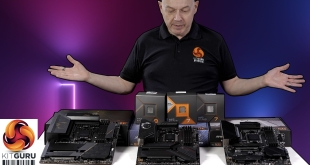When testing the Silverstone Precision SST-PS05 Chassis we feel it is important to record results as it is ‘sold' – meaning with just the single 120mm exhaust fan. That said, we also installed several 120mm fans to record any potential benefits by upgrading the cooling system.
While we would normally use Noctua 120mm fans, three of them cost more than the chassis, so we felt this wasn't a valid real world situation.
As we have a box of Akasa products in our offices we decided to fit three 120mm fans which cost around £5 each. These sleeve bearing fans produce 49.74 CFM while only generating 18.0 dBa of noise.
We measured between 24dBa and 28dBa from the supplied fan (controlled by our motherboard) so this is the foundation for a very quiet system.
System Build:
Silverstone Precision SST-PS05 Chassis
AMD Quad Core 955 Black Edition
MSI 890GXM-G65 Motherboard
Kingston 4GB DDR3 1600mhz (8GB kit review here)
Sapphire HD5670 Ultimate Edition (review here)
Thermaltake XT 675W PSU
Thermal Diodes
Raytek Laser Temp Gun 3i LSRC/MT4 Mini Temp
Digital Sound Level Noise Decibel Meter Style 2
We attached several diodes to key positions in the chassis. This is to measure the thermal prowess of the case with a single exhaust fan, and then any differences by adding others later. Remember out of the box the case only has a single exhaust fan at the rear, next to the CPU cooler, seen in the image below.
The CPU cooler is mounted with the fan directing air upwards, exhausted out the filtered vents as well as the rear, this is as close to a vertical air flow system (in the style of the Raven 02) we can achieve with this chassis.
With air conditioning, room ambient temperatures were kept at a steady 24c, comfortable conditions for most people. Idle temperatures were recorded after 30 minutes with the system resting in Windows 7. Load temperatures were recorded by playing Crysis Warhead for a 30 minute period and recording the maximum results. While we could use a mixture of Prime and Furmark I prefer real world conditions as it is applicable to the gaming audience reading this.
Diode measurement locations:
Ambient 1 (A1)
Ambient 2 (A2)
Ambient 3 (A3)
Ambient 4 (A4)
Power Supply location 1 (PSU1)
Power Supply Location 2 (PSU2)
Motherboard Ambient 1 (MB1)
Memory Heatspreaders (MEM)
Without any front intake fans or top mounted exhaust fans the chassis does a very good job of keeping things in check. Our room ambient is 24c and the internal chassis ambient warms up to about 4c+ after 20-30 minutes. Dead zones occur in A1 and A2 as well as PSU1 due to no front mounted intake fans.
Overclocking the system:
Next we will crank the Black Edition CPU to 3.9ghz by increasing voltage to 1.45. We also will overclock the graphics card from 775mhz core /1000mhz ram to 875 mhz core/1070mhz ram.
This is still only using the single rear mounted exhaust fan which is supplied.
The overclocked results are impressive considering the overall lack of air flow inside the chassis. Our positioning of the CPU fan to expel directly through the fins of the heatsink and upwards out help to ensure the CPU temperatures are very good.
Next we will add a front mounted 120mm intake fan (in the A2 position) as well as two 120mm exhaust fans to the top of the chassis. This means we have a single intake fan and 3 exhausting.
With the additional fans added we have cold air coming in from the front towards the graphics card and PSU area which helps to lower ambient temperatures. Adding two exhaust fans to the top means the CPU and memory areas will get a more active air flow.
The results below are taken with reference clock speeds and voltages.
Adding the intake fan certainly helps the ‘dead zones' in A1 and A2 and it also helps the air flowing upwards over the motherboard. It would also help lower hard drive temperatures a few degrees, although we are using an SSD in this particular build.
Overclocking the system:
Next we will crank the Black Edition CPU to 3.9ghz by increasing voltage to 1.45. We also will overclock the graphics card from 775mhz core /1000mhz ram to 875 mhz core/1070mhz ram.
Adding the three additional fans really helps to reduce ambient temperatures throughout the case, especially at the top. An extremely impressive set of results for a budget chassis.
 KitGuru KitGuru.net – Tech News | Hardware News | Hardware Reviews | IOS | Mobile | Gaming | Graphics Cards
KitGuru KitGuru.net – Tech News | Hardware News | Hardware Reviews | IOS | Mobile | Gaming | Graphics Cards









